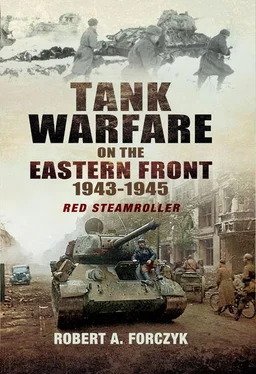Armour Deployed to the Western Front
The Third Reich had three-quarters of its armour deployed on the Eastern Front, with only small mobile forces deployed in the Western Front. Since the OKH lacked a strategic reserve – unlike the Red Army – the only armoured reserves that it could draw upon to deal with unexpected contingencies were either tired veteran units rebuilding in the West or new, inexperienced formations in training. There were no full-strength, combat-ready panzer units sitting around in reserve – everything was deployed at the front. Inside Germany, the Panzertruppenschule I at Munster and the Panzertruppenschule II at Wünsdorf had a cadre of experienced officers and NCOs, as well as tanks for training, which were not supposed to be used as a pool for forming operational tank units – but that rule would be broken late in 1943. Each Panzer-Division also maintained a Panzer-Ersatz-Abteilung to train replacements in its home Wehrkreis; these too would be tapped for use as ad hoc combat units later in the war.
Up until the end of 1942, Hitler had been able to avoid deploying Panzer-Divisionen to guard Western Europe, since the threat of Allied invasion had appeared negligible. Throughout 1942, France was regarded as a rear-area training zone, where decimated armoured units could be rested and rebuilt for about six months, before heading back to the Eastern Front. During the rebuilding phase, these units had not been required to maintain much ready combat capability and many of their vehicles were sent to depot-level maintenance while the troops were rotated home on leave. Panzertruppen resting in France were more interested in wine, women and sunshine, than in intensive training or coastal defence duties. However, that perception began to change when Commonwealth forces conducted the Dieppe Raid in August 1942, which included landing part of a battalion of Churchill tanks. Although a costly failure, the Dieppe Raid indicated that larger Allied amphibious landings, with much more armour, were a distinct possibility in the not-so-distant future. Emphasizing this growing vulnerability, the Anglo-American Operation Torch in North Africa in November 1942 indicated that Hitler would soon have to commit at least a few Panzer-Divisionen to protect both the Atlantic and Mediterranean coastlines. Consequently, the 1.Panzer-Division, which was pulled out of the Rzhev sector in December 1942, was first sent to France, but in May 1943 it was sent to cover the Greek coast for five months. As the threat of unexpected Allied amphibious landings increased throughout 1943, Hitler directed that a Panzer-Reserve would be created to cover contingencies in Western Europe.
In order to fulfill Hitler’s requirement, in July–August 1943 the Ersatzheer (Replacement Army) simply collected several of its Panzer-Ersatz Abteilung (Tank Replacement Battalions) and assorted other training units and cobbled them together into three new Reserve-Panzer-Divisionen. The 155. and 179. Reserve-Panzer-Divisionen were assigned to France and the 233.Reserve-Panzer-Division was sent to Denmark. These divisions could continue to train replacements, but were also tasked with providing a contingency reserve to oppose Allied landings. Although the 155.Reserve-Panzer-Division had 60 older Pz III and Pz IV tanks, none of these Reserve Divisions had much combat capability and they diverted precious training resources away from supporting the Eastern Front. {6}
In addition to the Reserve-Panzer-Divisionen, the OKH had begun forming two new Panzer-Divisionen in 1942, but priority was low so their formation occurred over an extended period. The 26.Panzer-Division was formed in Belgium from the battered 23.Infanterie-Division and Panzer-Regiment 202, but it would be mid-1943 before the division would be equipped and trained for battle. Due to Hitler’s paranoid fear of Allied landings in Norway, the 25.Panzer-Division had been pulled together in Oslo from various garrison units and a Panzer-Abteilung equipped with captured French tanks, but it barely amounted to a brigade-size Kampfgruppe before mid-1943. By September 1943, the 25.Panzer-Division was approaching full strength and was transferred to France. Even before the loss of the 14.,16 and 24.Panzer-Divisionen at Stalingrad, Hitler directed the OKH to set aside resources to rebuild these divisions and by spring 1943 this project would divert even more personnel and equipment away from the Eastern Front. Guderian bitterly opposed the formation of these new Panzer-Divisionen since they were depriving him of the resources to restore the divisions on the Eastern Front, but he was over-ruled. {7}
North Africa: Reinforcing Failure
Russian historians have often attempted to downplay the role of the Western Allies in the defeat of Germany – particularly the Anglo-American campaigns in North Africa – and criticized the lack of an earlier ‘Second Front’ to divert German resources from the Eastern Front. In fact, the North African ‘sideshow’ diverted significant German reinforcements from being sent to Russia and acted as a sinkhole for the limited pool of German armoured replacements, which were needed far more in the East. By January 1943, Generalfeldmarschall Erwin Rommel’s Deutsche Afrika Korps (DAK), which had the 15. and 21.Panzer-Divisionen, had been badly defeated by the British at the Battle of El Alamein in Egypt in November 1942 and was in full retreat into Libya. With the Americans and British having landed in Morocco and Algeria, it was clear that the Axis strategic position in North Africa was rapidly becoming untenable. Rommel recommended pulling these veteran troops back to mainland Europe where they could be re-equipped and provide a formidable mobile reserve for Western Europe.
However, in one of his more foolish strategic decisions, Hitler rejected the idea of evacuating Africa and instead ordered strong armoured reinforcements, including the refurbished 10.Panzer-Division and the newly-formed s.Panzer-Abteilung 501, to be transported to Tunisia to reinforce Rommel’s retreating forces. While this decision delayed the inevitable for five months, Hitler’s decision to send more than 300 tanks (including 31 Tigers) to Tunisia when the German Panzer-Divisionen in the East were reduced to threadbare strength represented a colossal mistake. Had these forces been sent eastward, von Manstein’s ‘Backhand Blow’ counter-offensive at Kharkov in February 1943 would have been nearly doubled in strength. Guderian opposed the diversion of this much armour to North Africa, particularly the Tigers, but he was ignored. Instead, by May 1943 all these reinforcements sent to North Africa would be eliminated, costing Germany three Panzer-Divisionen and a Panzergrenadier-Division, losses that would also have to be replaced out of hide. Like Stalingrad, German losses in North Africa were 100 per cent of equipment. Only small numbers of Panzertruppen were evacuated by air.
Diversion of Armour to the Waffen-SS and Luftwaffe
While the Heer panzer units were being bled to death in Russia and were often forced to make do with obsolete weapons, Reichsführer-SS Heinrich Himmler successfully lobbied Hitler to divert an enormous amount of men and equipment to convert three of his own Waffen-SS divisions to Panzergrenadier-Divisionen. Up to this point in the war, the Waffen-SS divisions had served as motorized infantry units, each with a battery of attached assault guns, and had limited experience with armoured operations. In 1942 the SS- Wiking Division had been given a single SS-Panzer-Abteilung, which was employed in the Caucasus. Yet Himmler did not want his troops to be used merely as a support force for the Heer, and sought to build up his best divisions into a mobile strike force capable of independent operations. During the winter of 1942–43, the SS-Panzergrenadier-Divisionen Leibstandarte Adolf Hitler (LSSAH), Das Reich and Totenkopf were refitted in France and each received a newly-created SS-Panzer-Regiment with two full-strength battalions. At a time when half of the Heer Panzer-Divisionen only had a single under-strength Panzer-Abteilung, Himmler ensured that his troops received the best; over 317 tanks went to outfit these six SS-Panzer-Abteilungen, including brand-new Pz III and Pz IV medium tanks. Himmler even connived to get each of these three Waffen-SS divisions its only schwere-Panzer Kompanie with 10 Tiger tanks. Once completed in early 1943, these three divisions were grouped into the I.SS-Panzerkorps and began preparing to transfer back to the Eastern Front.
Читать дальше








![John Stieber - Against the Odds - Survival on the Russian Front 1944-1945 [2nd Edition]](/books/405234/john-stieber-against-the-odds-survival-on-the-russian-front-1944-1945-2nd-edition-thumb.webp)



